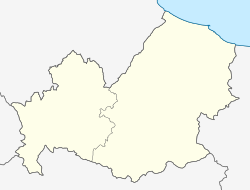|
Colletorto
Colletorto is a comune (municipality) of approximately 1,786 inhabitants[3] in the province of Campobasso, in the Italian region of Molise, located about 45 kilometres (28 mi) from the capital of the region Campobasso and 40 kilometres (25 mi) from Termoli (CB), sea town with port, railway and highway A14 (Adriatic line). GeographyColletorto is situated on a hill 508 m above sea level up to colle Crocella (776 m) in the Fortore river valley on the "Monti Frentani." The town is divided into two parts: the upper part is called "Colle" (Hill), and the lower is named "Terra," with the main road and center "Corso Vittorio Emanuele." Crossing the center, there is the old town district "Campo dei Fiori" (Field of Flowers) with the Parish church of Saint John the Baptist, the Palace of Marquis Rota (Local council domicile), and the Angioina Tower. The Angioina Tower is 25 m tall and was built in 1369 by Queen Joanna I of Naples, with views from the terrace on the Gargano mountain (Apulia), the Lesina lake, the Adriatic Sea and the Tremiti Islands. Near Colletorto is situated the Occhito lake, an artificial lake on the Fortore River that indicates the border with the Apulia region, the lake of Guardialfiera is 25 km away. Other important rivers on the territory are the Santa Maria torrent and the Cigno River, both branches of the Fortore River. The hills around Colletorto are divided into the forest of oaks, Mediterranean maquis, olive trees, and fields of cereals and other agricultural products. Colletorto borders the following municipalities: Carlantino, Casalnuovo Monterotaro, San Giuliano di Puglia, Sant'Elia a Pianisi. Main sights
EconomyColletorto's economy is mainly based on agriculture, which produces cereals and, especially, excellent-quality extra virgin olive oil. The "Oliva nera di Colletorto" is a native tree of Colletorto, and his oil is necessary to produce the "DOP Molise." The municipality, driven by the desire to enhance and make known the quality of the oil produced in the countryside of Colletorto, joins to the National Association of the City of Oil. In the countryside, there are about 250,000 plants that produce around 30,000 quintals of olives per year.[8] On the territory are present many oil mills, one paper factory and private workshops. Under construction, there is a health center for elderly persons. TransportColletorto is connected by public bus to the nearest towns and the mains in the province of Campobasso. The closest train station is Bonefro-Santa Croce station 14 km away on the regional line Termoli–Venafro railway. CultureThe city has many fairs and festivals, notably those of "Fuochi di Sant'Antonio" (17 January) and Saint John (29 August). These include parties and religious processions. The first is a very ancient and particular festival of Colletorto that mixes sacred and profane and it marks the beginning of the carnival. It consists of the preparation of bonfires by each quarter of the town that celebrates with typical food, drinks, and music until the morning around the fire.[9] The second is the patron saint's festival. Thanks to the geographical position of the town of Colletorto, in the days close to the summer solstice, it's possible to see the sun rising over the sea towards the Gargano. According to a belief, looking in that direction on the morning of June 24th it's possible to see the head of St. John the Baptist.[4] International relationsTwin towns — sister citiesColletorto is twinned with:
References
|
||||||||||||||||||||||||||||||||||||||||||||||||||||||



